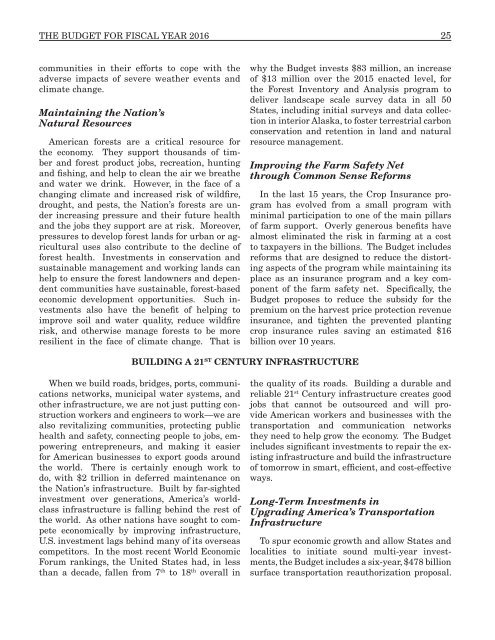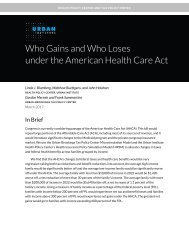BUDGET-2016-BUD
BUDGET-2016-BUD
BUDGET-2016-BUD
You also want an ePaper? Increase the reach of your titles
YUMPU automatically turns print PDFs into web optimized ePapers that Google loves.
THE <strong><strong>BUD</strong>GET</strong> FOR FISCAL YEAR <strong>2016</strong> 25<br />
communities in their efforts to cope with the<br />
adverse impacts of severe weather events and<br />
climate change.<br />
Maintaining the Nation’s<br />
Natural Resources<br />
American forests are a critical resource for<br />
the economy. They support thousands of timber<br />
and forest product jobs, recreation, hunting<br />
and fishing, and help to clean the air we breathe<br />
and water we drink. However, in the face of a<br />
changing climate and increased risk of wildfire,<br />
drought, and pests, the Nation’s forests are under<br />
increasing pressure and their future health<br />
and the jobs they support are at risk. Moreover,<br />
pressures to develop forest lands for urban or agricultural<br />
uses also contribute to the decline of<br />
forest health. Investments in conservation and<br />
sustainable management and working lands can<br />
help to ensure the forest landowners and dependent<br />
communities have sustainable, forest-based<br />
economic development opportunities. Such investments<br />
also have the benefit of helping to<br />
improve soil and water quality, reduce wildfire<br />
risk, and otherwise manage forests to be more<br />
resilient in the face of climate change. That is<br />
why the Budget invests $83 million, an increase<br />
of $13 million over the 2015 enacted level, for<br />
the Forest Inventory and Analysis program to<br />
deliver landscape scale survey data in all 50<br />
States, including initial surveys and data collection<br />
in interior Alaska, to foster terrestrial carbon<br />
conservation and retention in land and natural<br />
resource management.<br />
Improving the Farm Safety Net<br />
through Common Sense Reforms<br />
In the last 15 years, the Crop Insurance program<br />
has evolved from a small program with<br />
minimal participation to one of the main pillars<br />
of farm support. Overly generous benefits have<br />
almost eliminated the risk in farming at a cost<br />
to taxpayers in the billions. The Budget includes<br />
reforms that are designed to reduce the distorting<br />
aspects of the program while maintaining its<br />
place as an insurance program and a key component<br />
of the farm safety net. Specifically, the<br />
Budget proposes to reduce the subsidy for the<br />
premium on the harvest price protection revenue<br />
insurance, and tighten the prevented planting<br />
crop insurance rules saving an estimated $16<br />
billion over 10 years.<br />
BUILDING A 21 ST CENTURY INFRASTRUCTURE<br />
When we build roads, bridges, ports, communications<br />
networks, municipal water systems, and<br />
other infrastructure, we are not just putting construction<br />
workers and engineers to work—we are<br />
also revitalizing communities, protecting public<br />
health and safety, connecting people to jobs, empowering<br />
entrepreneurs, and making it easier<br />
for American businesses to export goods around<br />
the world. There is certainly enough work to<br />
do, with $2 trillion in deferred maintenance on<br />
the Nation’s infrastructure. Built by far-sighted<br />
investment over generations, America’s worldclass<br />
infrastructure is falling behind the rest of<br />
the world. As other nations have sought to compete<br />
economically by improving infrastructure,<br />
U.S. investment lags behind many of its overseas<br />
competitors. In the most recent World Economic<br />
Forum rankings, the United States had, in less<br />
than a decade, fallen from 7 th to 18 th overall in<br />
the quality of its roads. Building a durable and<br />
reliable 21 st Century infrastructure creates good<br />
jobs that cannot be outsourced and will provide<br />
American workers and businesses with the<br />
transportation and communication networks<br />
they need to help grow the economy. The Budget<br />
includes significant investments to repair the existing<br />
infrastructure and build the infrastructure<br />
of tomorrow in smart, efficient, and cost-effective<br />
ways.<br />
Long-Term Investments in<br />
Upgrading America’s Transportation<br />
Infrastructure<br />
To spur economic growth and allow States and<br />
localities to initiate sound multi-year investments,<br />
the Budget includes a six-year, $478 billion<br />
surface transportation reauthorization proposal.



